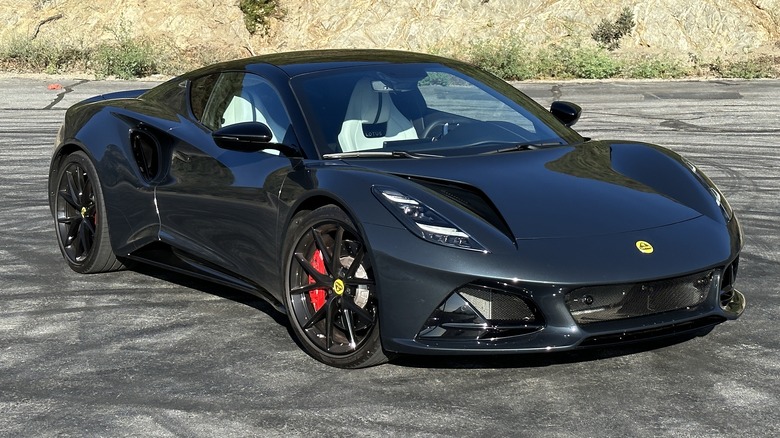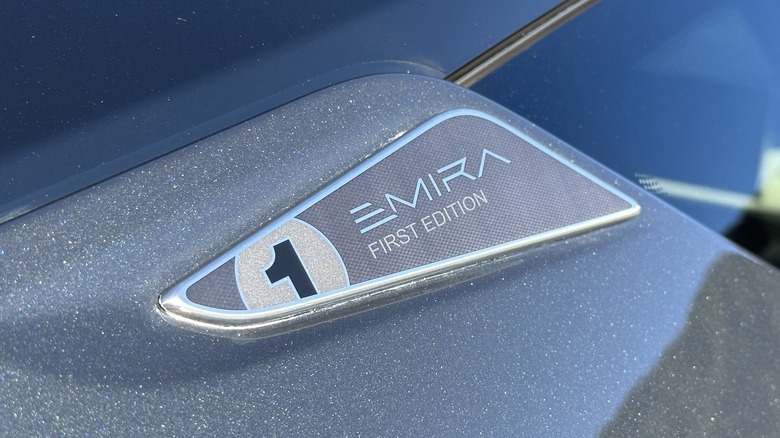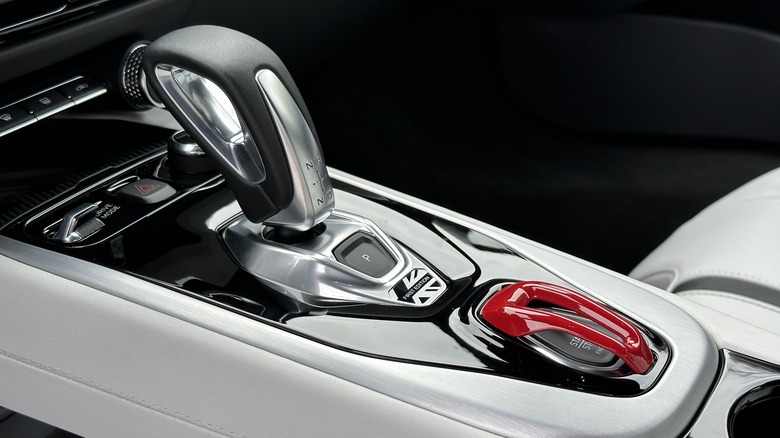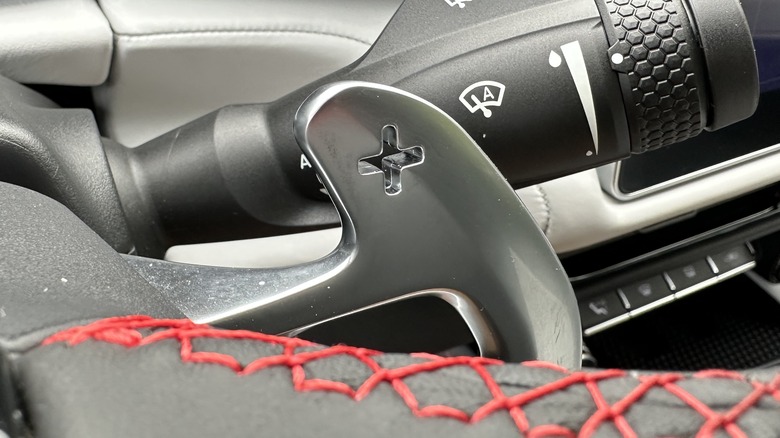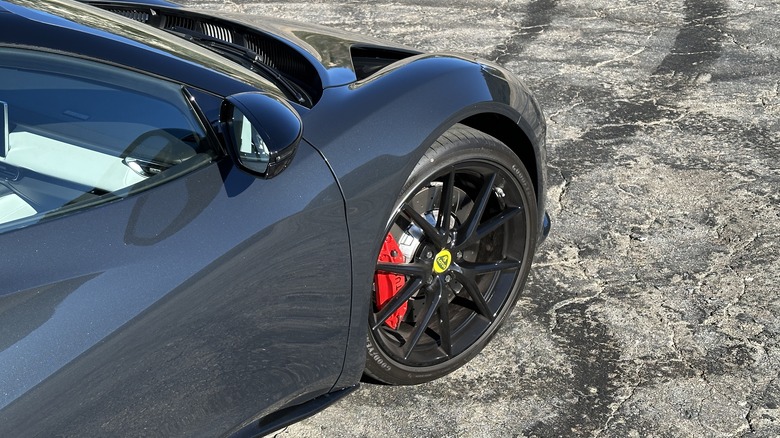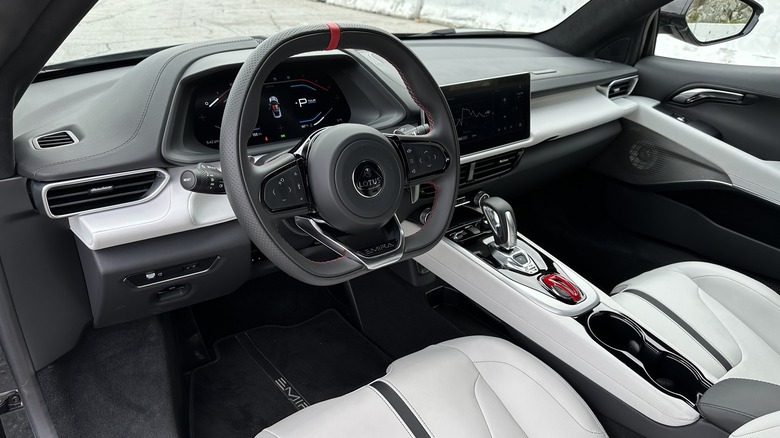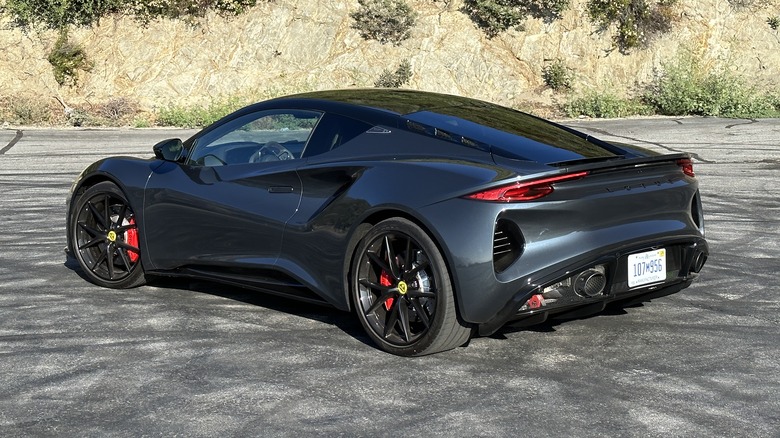2023 Lotus Emira Review: Does An Automatic Transmission Kill The Vibe?
- Punchy supercharged V6
- Superb handling
- Comfortable and well-appointed cabin
- Sluggish automatic transmission
- Laggy infotainment system
- Trunk compartment gets hot
As a lithe, driver-focused sports car, the Lotus Emira sure seems like concoction best stirred with a stick. As we found in our initial review, the Emira's six-speed manual transmission is an absolute joy to use, with a perfectly weighted clutch and a metal shift knob that's cool to the touch. Plus, every time you open the Emira's door, you can peep the exposed gearbox linkage below the center console. Tactile and aesthetically pleasing: what's not to like?
But like most modern sports cars, the Emira isn't a manual-only affair. If you spec an Emira with the supercharged V6 engine, you can optionally pair it with a six-speed automatic transmission. What's more, Lotus will soon offer the Emira with a 2.0-liter turbocharged inline-4 borrowed from Mercedes-AMG, which will only come with an 8-speed dual-clutch 'box.
That in mind, I can't help but wonder: Is the DIY approach to shifting an absolute must? Or can the Emira still boogie with two pedals and a pair of paddles on board?
Lotus Emira: A quick refresher
Despite being brand new, the Emira also marks the end of an era. It's the last internal-combustion-powered car Lotus will ever build, with the company's future instead defined by products like the fully electric Eletre SUV and Emeya sedan.
Really, the Emira just picks up where the old Evora GT left off. The Emira uses the same 3.5-liter V6 as its predecessor — not to mention a handful of decade-old Toyotas — with an Edelbrock supercharger bolted on for good measure. This combo makes a hearty 400 horsepower and, if you get the 6-speed automatic transmission, 317 pound-feet of torque. Manual cars have 310 lb-ft; the automatic's extra shove is due to its traditional torque converter.
Regardless of transmission, Lotus quotes a 4.2-second 0-to-60-mph time for the Emira. But with the V6's supercharged wail happening just behind your head, launching this car is a visceral and exciting experience — far more so than its 4.2-second time would suggest.
Now, about that automatic...
Lotus previously offered the Evora GT with a six-speed automatic gearbox, which was, well, bad. Slow and dimwitted, this transmission was the absolute definition of a slushbox, and while it didn't totally ruin the Evora GT experience as a whole, it really felt like a bad combo.
Fast forward to today, and while I'm happy to report that the automatic Emira is better, I'm still not impressed. Lotus improved the automatic transmission slightly, and its shifts are noticeably quicker and better timed than in the Evora. That said, the six-speed has a tendency to clunk around while driving in the city, and you have to lay into the throttle to get it to kick down on the highway.
Switching the drive mode from Tour to Sport improves the transmission's response a little, making it more eager to downshift. A pair of steering wheel-mounted paddles let you take matters into your own hands, but the action of these shifters is lame, with no tactile satisfaction and delayed responses to inputs. What's the point of having paddles if they aren't compelling to use?
Another auto option is coming
A lot of the automatic Emira's problems come down to slow shift times, which is something that could be solved with a more modern dual-clutch gearbox. This leaves me particularly eager to drive the four-cylinder Emira, which is down on power compared to the V6 car, but has a quicker-acting transmission.
In the Emira, the AMG-built 2.0-liter turbo I4 engine makes 360 hp and 317 lb-ft of torque. With an eight-speed dual-clutch gearbox sending power to the rear wheels, Lotus says the four-cylinder Emira can sprint to 60 mph in 4.3 seconds which, for those of you keeping track, is only one-tenth of a second slower than the V6 car.
Redemption through handling
Thankfully, the V6's six-speed automatic doesn't ruin what I love most about the Emira: its handling. Taking away the manual transmission lowers the driver involvement quotient a bit, but this is still an exceptional sports car. Light on its feet and full of feedback, the Emira is a reminder that Lotus absolutely knows how to tune a chassis, with communicative steering and a lively and tossable nature.
Some of that goodness comes down to the Emira's relatively old-school mechanicals, a highlight of which is the hydraulic steering. Modern electronically assisted steering racks tend to filter out some of the road-level communication that makes sports cars so sweet, while older hydraulic setups feel much more lively in your hands. In a car like the Emira, that's a great quality to have.
The Emira's drive modes don't alter things like steering weight or damper stiffness, which is fine, since Lotus tunes this car perfectly from the get-go. The V6 First Edition models are available with either Touring or Sport suspension setups, and my test car has the former, which makes it a little more livable while driving on pockmarked city streets. The Touring spec also rides on Goodyear Eagle F1 summer tires, rather than the Sport's more aggressive Michelin Pilot Sport Cup 2s.
A lovely cabin with a touchy shifter
The Emira's automatic transmission is managed via an electronic shifter, and it's the same one you'll find in a Volvo, meaning it has the annoying double-tap up for Reverse, double-tap down for Drive action. (Volvo and Lotus have the same Chinese parent company: Geely.) However, using an electronic shifter means the Emira has much more free space underneath the center console, so there's a larger storage area for things like electronics or your purse, and there's a USB-A port down there, too.
Overall, the Emira's cabin is super nice — a huge improvement over the old Evora GT, at any rate, which relied on 20-year-old Ford and General Motors switchgear. (Seriously.) The fit and finish of my pre-production First Edition test car is quite good, with no squeaks or rattles to speak of, and all the leather-wrapped surfaces are soft to the touch. There's a measly 5.3 cubic feet of storage space in the trunk, but it's not like you're buying the Emira for its cargo-hauling prowess. Just be careful what you put back there: With the engine in such close proximity, that storage area gets warm — fast.
Multimedia wise, the Emira is a little finicky. The 10.2-inch touchscreen can run Apple CarPlay or Android Auto wirelessly, but Lotus' native software is sometimes slow to boot up and the menu structure is somewhat confusing. But hey, I suppose anything is better than the Evora GT's old Alpine-branded head unit that you could honest-to-god find on an aftermarket stereo shelf at Best Buy.
2023 Lotus Emira verdict
Look, I'm not one of those "save the manuals!" luddites who bemoans the existence of automatic transmissions. I love modern autoboxes, and there are some truly great ones out there: ZF's eight-speed or Porsche's PDK seven-speed, for example. But the Emira is a great sports car let down by its transmission. If the V6 model had a more sophisticated gearbox, I really think it'd be a hoot.
On top of the Emira V6 First Edition's $105,400 base price, the automatic transmission is a $2,150 add-on. That's not as bad as a Porsche 718 Cayman GTS 4.0, where the dual-clutch gearbox is a $3,730 upcharge. But then again, with Porsche's PDK, you're paying for impeccable engineering.
As it stands, it's tough to recommend an Emira with the automatic transmission. But maybe the quicker-shifting DCT in the Emira 2.0T will change my mind.
